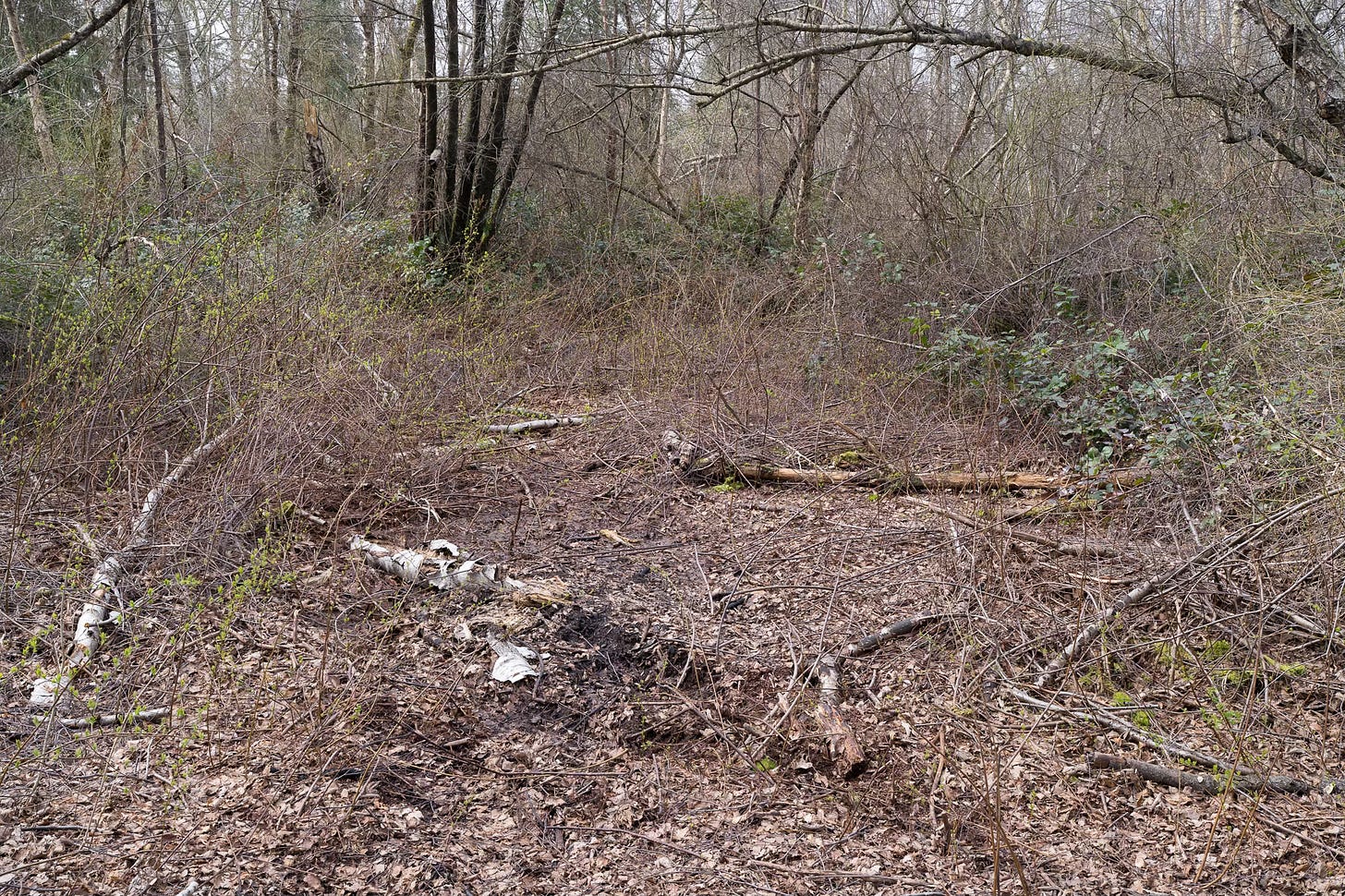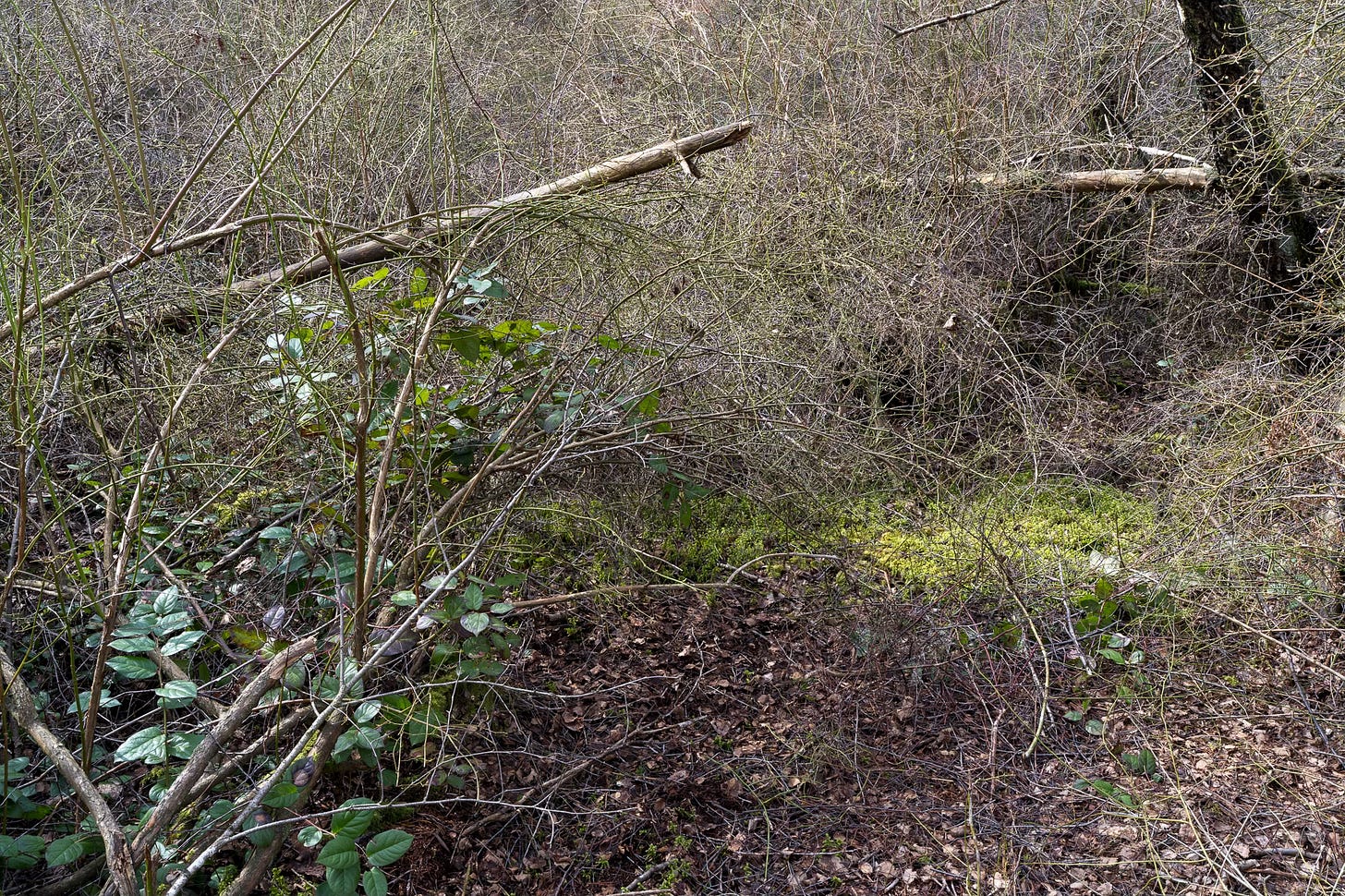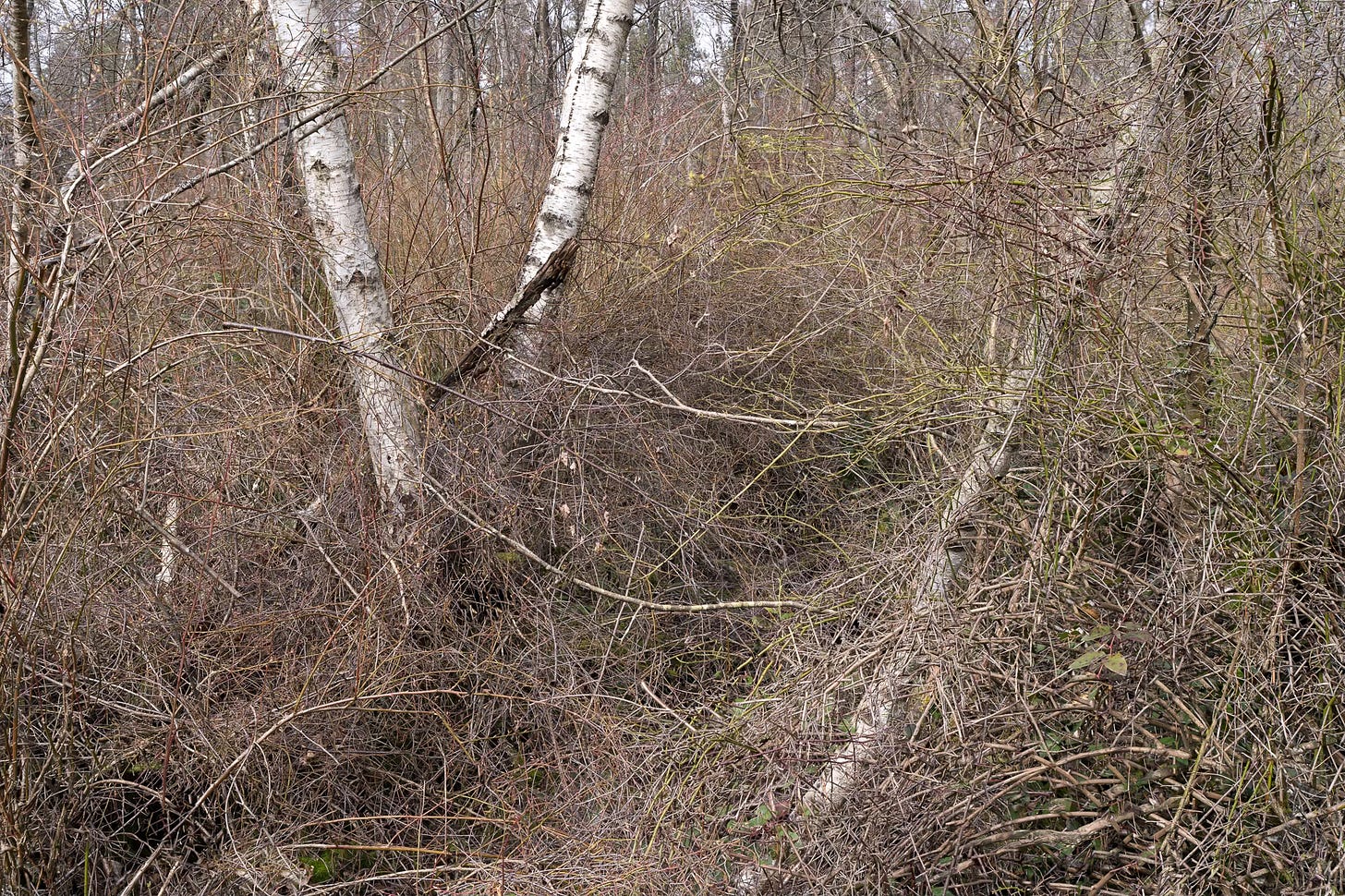From Narrative to Typology
It’s about 5:30 am, and I’m heading out to take some photos. I feel driven to finish a project because I’m leaving British Columbia next week for New York City, and by the time I get back, the trees and bushes in the woodlands will be so different; it will seem like a different time of year, and for some specific reasons, I want a sense of consistency in the images. If I don’t finish now, it will mean waiting until next year.
Let me tell you about these photos.
This photograph is of a dense thicket of leafless and tangled branches interspersed with remnants of white-barked birch trees. For the most part, the birch trees stand at an angle, leaning. Seemingly slowly falling over a period of year. These dying trees shed entire branches, and their white bark shows far across the woodland. There is a startling contrast between the remains of the branches and some of the places they fall. Usually, they are scattered on the ground, with some pieces caught in the web of underbrush, making bright white lines. There is a bad case of birch dieback here. Usually, this is caused by too little water, but here in BC, it’s often too much water and clay-heavy soil. When you walk along the pathway, your boots often become clogged with mud or what looks like mud. But it’s the clay. A lighter shade of what you at first think is soil. It’s hard to wash out of your clothing. These woodlands are full of things that want to cling and hitch a ride in the bog, which includes the ground itself.
While this image might seem fairly typical for a woodland photograph, I have, over time, moved toward images that are more typological than landscape per se. I have always tried, in a series, to give a sense of narrative. A sense of going from one place to another. But here, I wanted to focus on a closer study of details, of smaller things often overlooked. I especially wanted to show the little-noticed sense of slow time: the small twigs, last season’s branches and new green tendrils. These little, quiet, minor photos of barely anything reflect a sense of extended time. That's what I wanted to focus on right now. And that’s best demonstrated by showing the consistency of the moment…not the flow of a season or the following of a pathway.
That’s why I don’t want to wait until growth begins to cloud the view. So rather than pathways and their inherent narratives, I’m focusing on Typologies, borrowing from architectural and anthropological classification methods used by many of my favourite photographers. Of course, there are Bernd and Hilla Becher. And their students, Andreas Gursky, Thomas Struth, and Candida Höfer. Looking at similar things just naturally leads us to find the differences, differences that might have been hidden if the process were not controlled.
Walking along the shallow creeks this morning, I suddenly find myself being pulled down through the surface as the clay surrounds me. You pick up a bit of the mud and feel it between your fingers. It’s oddly slippery. You smell it; maybe, like me, you remember it’s just like the clay you used in elementary school.
Moving in and out of the creeks throughout the bog can be difficult as I often find myself caught behind a wall of undergrowth that includes prickers and really vicious thorns; last year's growth is often a white or ash colour, reminding me of a bird of small mammal skeleton I might come across in a clearing. These days when I enter the bush I carry a set of garden clippers in my back pocket as the new growth often reaches across my path, catches me, and pulls larger, more deadly vines of thorns towards me. I find my clothing caught, and like today, when home taking a shower, I find a dozen or so small, red and bleeding wounds from this encounter. The Clippers are a good defence. All seemed quiet and motionless, but the plants caught up to me when I wasn't paying attention.
Looking across the woodland, above the underbrush, I again see the birches leaning, collapsing in on themselves, shedding branches and scattering more white lines randomly on the top surface of the thicket and underbrush. All around me, there is a sense of devastation, death, and permanent change. Little of it makes me think of the renewal of spring. At times, I feel a bit claustrophobic. It’s easy to become surrounded. I feel my back pocket. Yes, the clippers are still there in my pocket. I am reminded, by my need to carry the clippers, that the sublime almost always includes a small threat, a bit of chaos, a sense of foreboding and danger
The photos are complex, living, full of evolving structures made of twigs, branches, and tendrils. The composition is chaotic yet immersive, with no clear focal point, offering a uniform field of organic textures. The image resists the traditional picturesque approach to landscape photography, eschewing grand vistas or dramatic lighting in favour of an intimate, almost impenetrable wilderness. The muted tones of brown, gray, and pale green contribute to a subdued atmosphere, emphasizing the complexity of natural decay and regrowth. I stand and look into the woodland again and notice a structure; then, suddenly, it’s hard to see. In this thicket, you often think you see things when you do not.
I notice a swirl, a tentative circular pattern. When I take a step back, the darker twigs and tiny branches from last year seem to have some communal purpose and it makes me look for further evidence.
There is a broader history of artistic inquiry into the aesthetics of the “minor landscape,” a term used to describe scenes like these that lack a conventional compositional hierarchy or visual grandeur. I like the term “anti-heroic.” Images like these challenge the notion that landscape photography must offer clear narratives or focal points, instead inviting viewers into a slower, more contemplative mode of looking. In this way, the photograph engages with contemporary environmental concerns, suggesting a vision of nature that is unruly, entangled, and resistant to human-centred narratives. Even in these confusing selections of nature, there is the whisper of a political message. I think nothing does more damage to our environment than an emphasis on the heroic and romanticized beauty at the expense of what is right beneath our feet. This is a quiet photo, a quiet moment, and a quiet protest. I look around, over the top of the brambles to see the birches again. I have time to wait, I want to hold off and take the photo when the wind has finally died down.
You can help me out by restacking my essays and photos. Also, please, join the conversation by signing up. Subscribe. And if you’d like to see more of my work visit www.jimroche.ca












Jim, I am loving your "minor landscapes". I am also drawn to making these types of images - they are far more representative of 99% of the time in the bush, where there is far more scenes of thick scrub than awe inspring vistas - but they are very hard to do well.
I like this “anti-heroic” landscape idea. Something refreshing about resisting the need for a narrative and just sitting with quiet chaos.